
Diving at the reef
Great Barrier Reef and pictures of dives
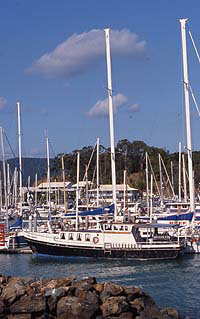 |
If you have a medical permission for diving you should explore the underwater world of the Great Barrier Reef. I hadn't been diving before and decided to do the Open Water Diver course at the reef. The Open Water Diver is the lowest SCUBA-diving level that permits diving down to depths of 18m (SCUBA = self-contained underwater breathing apparatus). I had so much fun that I quickly decided to do the second level as well. The Advanced Open Water Diver permits diving down to depths of 30m. | ||
| The Open Water Diver course first includes five theoretical modules which are finished by a test. In addition there are five practical modules that teach you e.g. how to deal with your equipment. You do exercises with your buddy (dive partner) and it is important that you can trust him or her, because under water you can only communicate by sign language. After education in the pool and your classroom you have to do four dives in open water in order to receive the certificate Open Water Diver. | |||
| Divers might possibly be lazy people by nature ;-) Because the good dive territories are normally situated apart the coast you might have time to relax on the sun-deck of the boat that is taking you out. But you should never underestimate the exhaustion you will suffer from after a few dives. | 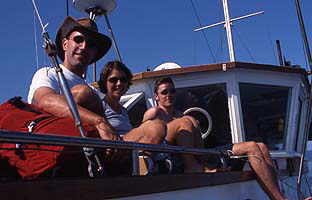 |
||
| Being outside all the time you will lose much water because air and sea water are very salty. In addition the salt in the air and the water surface will intensify the incoming sun light. Every diver should drink, drink and drink. But there is the same rule that is valid for pilots, parachuters or drivers: No alcohol! | |||
| My first dive in Blue Pearl Bay lasted 22 minutes and I went down to 10m. This new experience was very exciting but I had problems with the bouyancy. During my second dive I was down for half an hour and was enthusiastic about the colourful scenery. For the next dives we changed our boat. We went to the outer Great Barrier Reef for three days, a place called Elizabeth Reef. In my third dive I had to do some navigation exercises but I as well started to observe the environment in order to find out what I saw afterwards with the help of a book about reef fish. With the fourth dive where I did some more navigation exercises and a controlled emergency ascent I finished the Open Water Diver course. We were all happy holding the temporary certificate in our hands. Later at home we received the PADI-pass (PADI = Professional Association of Diving Instructors) that allows us to rent and buy dive equipment on our own. | |||
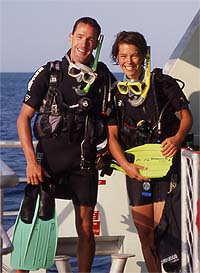 |
Because many of us proceeded to the Advanced Open Water Diver course we had soon to do our first night dive. At night the colours of the reef should be more natural because there is no selection by the absorbed sunlight. But it seems that I was too far away of the objects with my light because I was very disappointed of the colours. The highlight of this dive was a white tipped reef shark that passed us with his calm but powerful movements. These sharks are normally not dangerous for divers. You must know: If you behave carefully and considerately you will normally escape dangers. | ||
| Another duty of the Advanced Open Water Diver course is a deep dive, because the certificate allows diving down to 30m. Here we were made aware of the change of our body constitution that is caused by the enormous pressure in the depth. Because of the increased nitrogen in your body your senses are dazed. You behave a little bit as if you are drunken. This phenomenon is called nitrogen narcosis. Being down at 30m depth we were supposed to write our name backwards and solve the mathematical expression 83-27+17-14 = ?. Our instructors took the time and afterwards we were confronted with the results that showed us how slowly we were thinking down there. | |||
| Soon we received our temporary certificate Advanced Open Water Diver so that the following dives were pure fun. The highlights of these dives were e.g. huge clams, sea stars, white tipped reef sharks and moorish idols. | 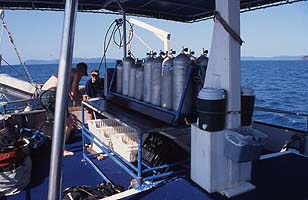 |
||
| An outstanding highlight was the clown anemone fish which lives in simbiosis with the sea anemone. The tentacles of the anemone are poisonous for most animals of the marine fauna but not for the clown fish. The clown fish hides between the tentacles when he feels danger. His service in return is that he brings food for the anemone. | |||
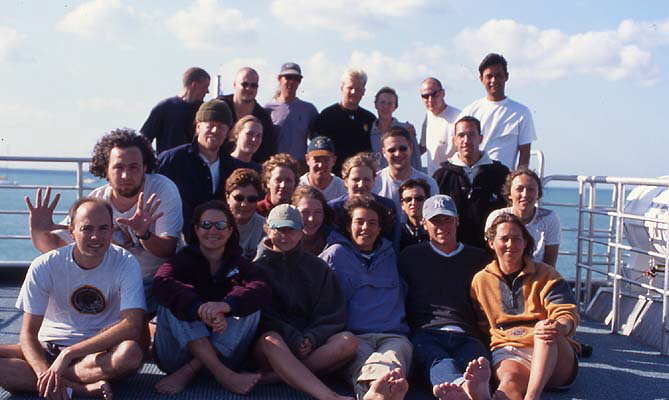 |
|||
| In total I did 14 dives in Australia. I started the first 12 dives from Airlie Beach in Queensland. For the last two dives I went to Green Island starting from Cairns on a one-day trip. Here I saw the largest clam of my dives which had a diameter of half a meter (I thought it was even larger but under water everything appears bigger that it really is). In addition I once again enjoyed the behaviour of the clown fish and the anemone :-) | |||
| Great Barrier Reef and pictures of dives | |||